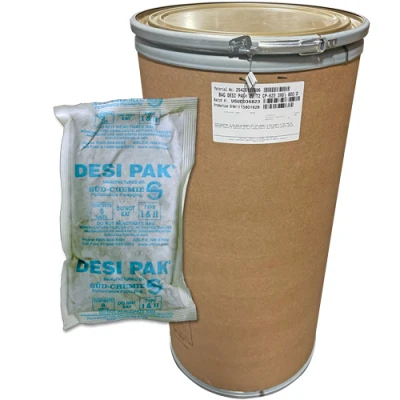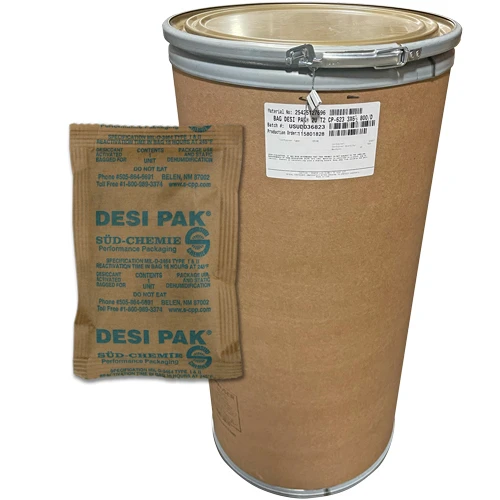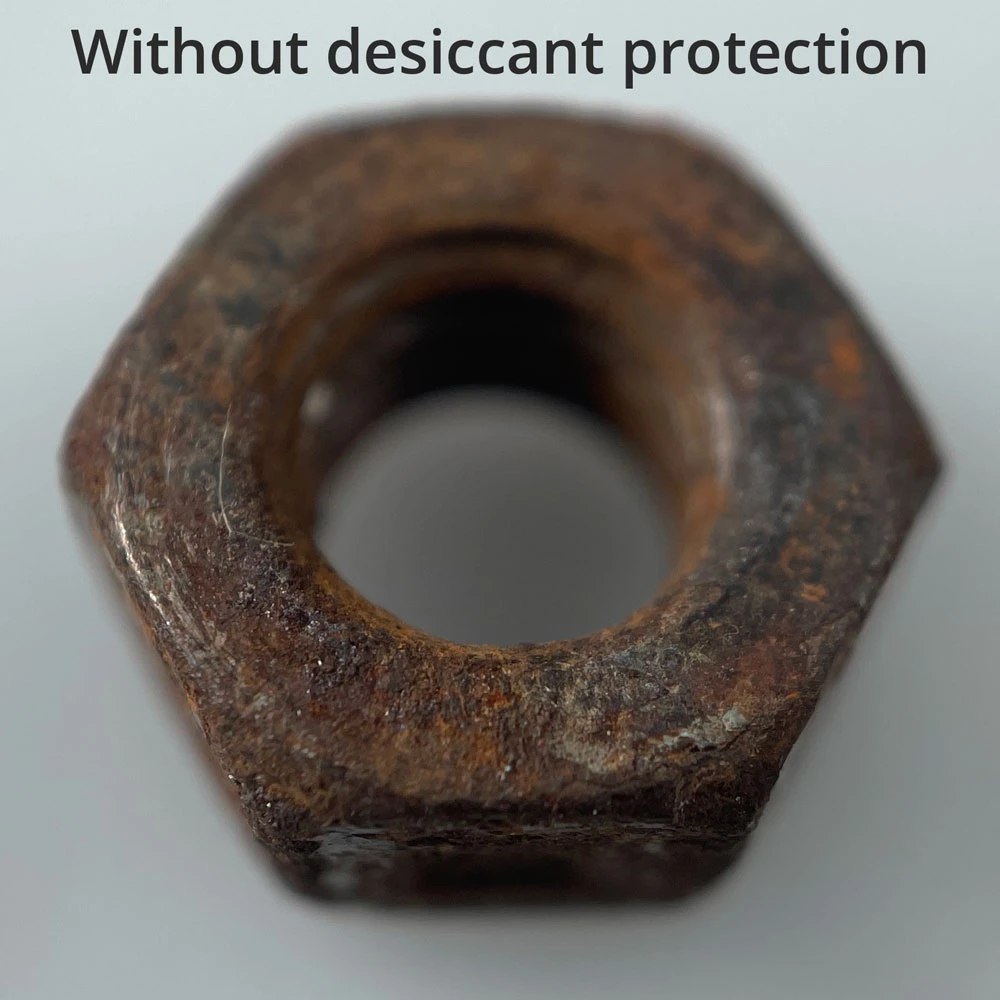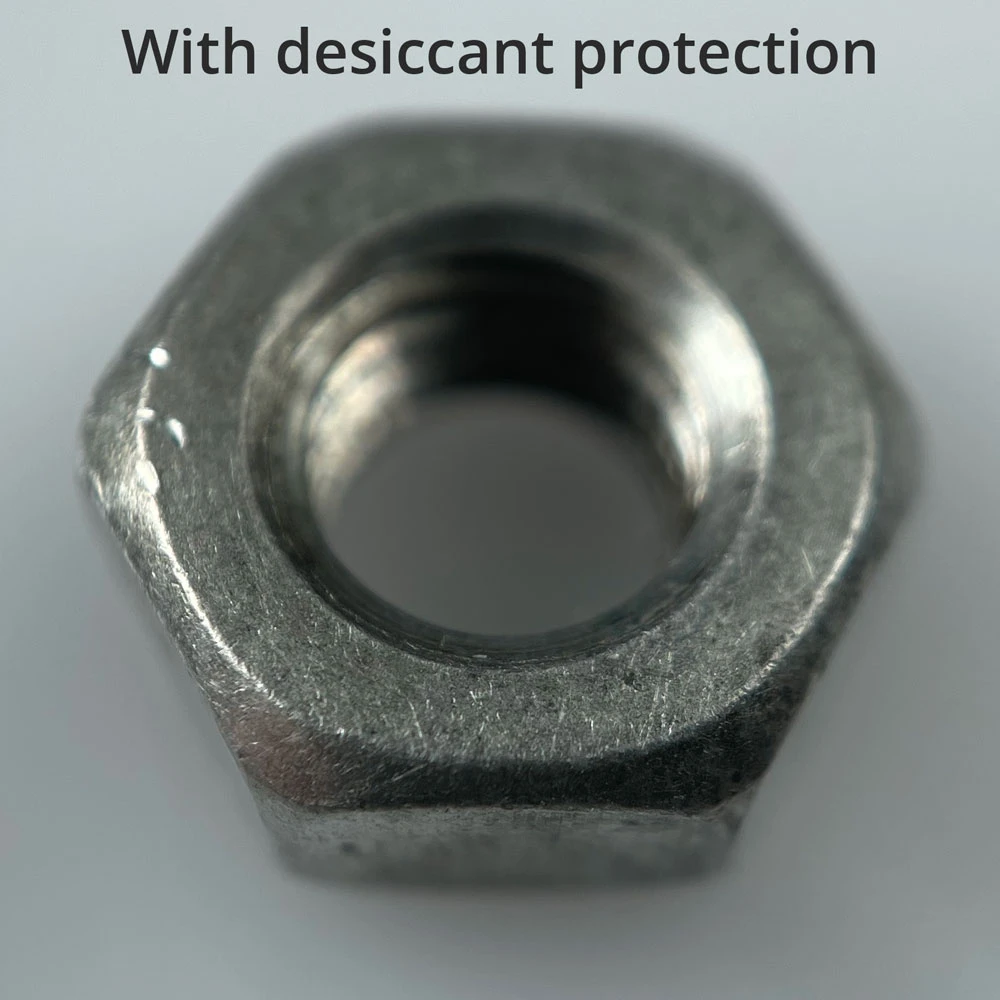Recently Viewed
to select
to navigate
esc to close
Popular Pages
Recently Viewed
Go Back
Custom Packaging
Bags & Liners
Tubing & Film
Packaging Supplies
Shop by Application

Hi there,
how can we help you today?
Shipping options will change based on location.
Current ZIP Code:
Update zip code
User my current location
Order before 4pm EST for same-day shipping on in-stock items!
Lowest Price Guarantee
30-Day Returns & Exchanges
100% Satisfaction Guarantee
Quantity
Desiccant packs are used as a dehumidifier to control moisture in contained environments, including pharmaceuticals, medical, diagnostics, food, electronics, and optical industries. Clay Desiccant Packets are made of an aluminosilicate clay compound, a natural mineral that is more economical than silica gel. At 20% relative humidity, Desi Pak will adsorb 50% more moisture than required by Mil-D-3464E, whereas silica gel will only adsorb 3.5% more moisture than required by Mil-D-3464E. The chart under the pricing estimates the number of Desiccant Packets required for moisture protection. Bentonite desiccants are all-natural and absorb moisture in packaging to prevent damaging effects such as corrosion, mold, and degradation. The production of clay desiccants has less impact on the environment as no harsh chemicals are used during production compared to silica gel desiccants.
Filter this list
| Stock # | Description | Qty/Drum | Price |
|---|---|---|---|
| BAG Desi Pak 2U T2 TY-695 3X6 | 800 / Drum |
As low as $375.80 |
|
| BAG Desi Pak 4U T2 TY-523D 5X5.5 | 500 / Drum |
As low as $339.35 |
|
| 8 Clay Desiccant 5 x 8 | 300 / Drum |
As low as $349.00 |
|
| 16 Clay Desiccant 5.75 x 10 | 150 / Drum |
As low as $315.30 |
|
| 80 Clay Desiccant 8.75 x 12.5 | 30 / Drum |
As low as $328.45 |
|
| Stock # | Description | Qty/Pail | Price |
|---|---|---|---|
| PKT Desi Pak 1/6U TY 27X64 | 1200 / Pail |
As low as $151.80 |
|
| PKT Desi Pak 1/3U TY 27X89 | 700 / Pail |
As low as $99.65 |
|
| BAG Desi Pak 1U T2 TY 641 3X4 | 300 / Pail |
As low as $99.50 |
|
| Stock # | Description | Qty/Drum | Price |
|---|---|---|---|
| 2 Clay Desiccant 3 x 6.5 | 800 / Drum |
As low as $359.15 |
|
| 4 Clay Desiccant 5 x 5.5 | 500 / Drum |
As low as $310.85 |
|
| Stock # | Description | Qty/Pail | Price |
|---|---|---|---|
| 1/2 Clay Desiccant 3 x 3.5 | 550 / Pail |
As low as $125.35 |
|
| 1 Clay Desiccant 3 x 4.5 | 300 / Pail |
As low as $98.05 |
|
| 2 Clay Desiccant 3 x 6-1/2 | 150 / Pail |
As low as $83.20 |
|
No results found, please check your filters!
Clear Filters
Link copied
See Results

Desiccant packs are used as a dehumidifier to control moisture in contained environments, including pharmaceuticals, medical, diagnostics, food, electronics, and optical industries. Clay Desiccant Packets are made of an aluminosilicate clay compound, a natural mineral that is more economical than silica gel. At 20% relative humidity, Desi Pak will adsorb 50% more moisture than required by Mil-D-3464E, whereas silica gel will only adsorb 3.5% more moisture than required by Mil-D-3464E. The chart under the pricing estimates the number of Desiccant Packets required for moisture protection. Bentonite desiccants are all-natural and absorb moisture in packaging to prevent damaging effects such as corrosion, mold, and degradation. The production of clay desiccants has less impact on the environment as no harsh chemicals are used during production compared to silica gel desiccants.
Formula: Units = 0.011 x Bag Area (in.²)
Example: 10" x 10" ClearZip® Bag.
Bag Area: 10" x 10" x 2 sides = 200 in.³
Units Needed: 0.011 x 200 = 2.2 Units
A desiccant is a dehumidifying agent which attracts moisture from the atmosphere. It adsorbs and holds particles of water to itself. Desiccant Packets are small sachets of Desiccant clay, aimed at protecting goods from moisture. The three most common types of desiccants are clay, silica gel, and molecular sieve. Desiccant Packets help protect products in a wide range of industries, including pharmaceuticals, nutraceuticals, diagnostics, food, and electronics, from moisture.
A desiccant is a substance that removes moisture from the surrounding air. When sealed in an air-tight container, such as a plastic bag, a desiccant pack will produce a low-humidity environment within the poly bag or any sealed container.
| Volume | UNITS REQUIRED | STOCK # | ||
| CU. IN. | CU. FT. | GAL. | ||
| 237 | 0.14 | 1.1 | 1/6 | DS01 |
| 476 | 0.28 | 2.1 | 1/3 | DS02 |
| 715 | 0.42 | 3.2 | 1/3 | DS03 |
| 1,429 | 0.83 | 6.2 | 1 | DS04 |
| 2,857 | 1.67 | 12.5 | 2 | DS05 |
| 4,286 | 2.50 | 18.7 | 3 | DS05 |
| 5,714 | 3.33 | 25.0 | 4 | DS06 |
| 7,143 | 4.17 | 31.2 | 5 | DS06 |
| 8,571 | 5.00 | 37.4 | 6 | DS06 |
| 10,000 | 5.83 | 43.6 | 7 | DS06 |
| 11,423 | 6.67 | 50.0 | 8 | DS07 |
| 12,857 | 7.50 | 56.1 | 9 | DS07 |
| 14,286 | 8.33 | 62.3 | 10 | DS07 |
| 17,143 | 10.00 | 74.8 | 12 | DS07 |
| 20,000 | 11.67 | 87.3 | 14 | DS07 |
| 22,857 | 13.33 | 99.7 | 16 | DS08 |
| 28,571 | 16.67 | 125 | 20 | DS08 |
| 42,857 | 25.00 | 187 | 30 | DS08 |
| 57,143 | 33.33 | 249 | 40 | DS08 |
| 71,429 | 41.67 | 307 | 50 | DS08 |
| 85.714 | 50.00 | 367 | 60 | DS08 |
| 100,000 | 58.30 | 432 | 70 | DS08 |
| 114,286 | 66.67 | 493 | 80 | DS09 |
| Industries that use desiccants | Products that are packaged with desiccants | |
| Aerospace | Batteries | Optical devices |
| Apparel | Bulk powdered chemicals | Pet foods |
| Automotive | Cholesterol tests | Photographic equipment and film |
| Communications | Circuit boards | Powdered or beaded glass |
| Dental | Clothing | Pregnancy tests |
| Diagnostic | Documents and paper storage | Relays and communication devices |
| Education | Electronic components | Safes |
| Electronics | Flour, sugar, grains | Shoes |
| Film Making | Glucose tests | Semiconductors |
| Food Packaging | Industrial equipment | Vitamins |
| Foodstuffs | Instruments | |
| Industrial | Leather products | |
| Medical | Machine Parts | |
| Military | Medical equipment | |
| Nutraceutical or Bioceutical | Metal and machine parts | |
| Optics | Metal powders | |
| Packaging | Military instruments and armaments | |
| Pet Food | Motors | |
| Pharmaceutical | Museum Storage | |
| Textiles | Oceanographic devices | |
| Film | Composition | Porosity |
| Tyvek | Spun-bonded polyethylene | 50-100 sec |
| Kraft (X-Crepe) | Cross-creped kraft paper | 5-25 sec |
| GDT-2 | BT-060E non-woven 65% polyester / 35% polypropylene | 5-25 sec |
| Sewn Bags | Non-woven rayon | 5-25 sec |
| MP-20 | 2 mil polyethylene/0.48 mil polyester clear film | N/A |
Why use desiccants?
Products vulnerable to moisture damage need special protection during storage and transport to remain effective. Desiccant Packets provide a simple, dependable, and economical solution for preventing moisture damage in small, sealed packages. A popular Desiccant Packets configuration in the pharmaceutical industry, Desiccant Packets are also ideal for protecting nutraceuticals, diagnostics, electronics, food, and products from moisture.
What are common uses of desiccants?
What size bags, packets, and canisters are available?
Standard sizes for unit bags are as follows: 1/6, 1/3, 1/2, 1, 2, 4, 8, 16, and 80 units. One unit is roughly one ounce of desiccant material.
Standard sizes for packets are as follows: 1/4, 1/2, 1, 2, 3, 5, and 10 grams.
Standard sizes for canisters are as follows: 1/2, 1, 2, and 3 grams.
What is a desiccant "unit"?
In desiccant terminology, a "unit" is the quantity of desiccant required to meet the U.S. Military's specification (MIL-D-3464E) for packaged desiccant products. Under this specification, a unit is the quantity of desiccant that will adsorb 3.00 grams of water vapor at 20% relative humidity or 6.00 grams of water vapor at 40% relative humidity at 77°F (25°C).
How do you use desiccant packs?
How to Store Desiccant Packs?
Unused desiccant packs should be stored in an air-tight container. To preserve their effectiveness, they should be kept in the case immediately before use.
What are clay desiccants?
Clay desiccants are non-hazardous, moisture-absorbent substances created by the controlled drying of calcium (bentonite) aluminosilicate clay. This naturally occurring montmorillonite clay has a special affinity for moisture and is chemically inert and non-corrosive.
Clay is the least expensive of all desiccants and highly effective within normal temperature and relative humidity ranges. It is used in most industrial applications requiring humidity control. Clay desiccant can adsorb up to 28% of its weight in water vapor at 77°F (25°C) and 80% relative humidity.
Clay desiccant packs work satisfactorily below 120°F (49°C). Above 120°F (49°C), there is a possibility that the clay will give up moisture rather than pull it in (silica gel or molecular sieve are suitable for such temperatures).
How are desiccants packaged?
Desiccants are generally packaged in bags, 5-gallon buckets or pails, packets, canisters, or fiber drums. (Packets are sometimes referred to as "sachets" or "pouches.")
Desiccants in bags are commonly referred to as industrial desiccants. They are primarily used by industry because their medium to large size enables them to adsorb moisture in heavy-duty applications.
Bagged desiccants are available in:
Tyvek (heat sealed)
Kraft paper (heat sealed)
Lantuck non-woven rayon/polyester blend (string sewn)
The term "bagged" desiccants commonly refers to any desiccant that is packaged by the unit.
What is the difference between a Tyvek clay desiccant and a kraft paper desiccant
The key differences between Tyvek clay desiccants and Kraft paper desiccants lie in the materials used for the packaging, durability, breathability, and specific applications:
Tyvek is a registered trademark of Dupont. / Desi Pak is a registered trademark of Süd-Chemie / Süd-Chemie is a division of the Clariant Company







